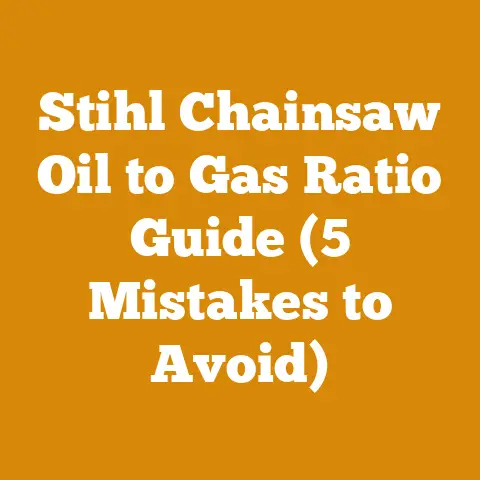Craftsman 16in 36cc Chainsaw Maintenance Tips (5 Pro Hacks)
“Maintaining your chainsaw is like sharpening your axe – a dull one makes hard work even harder,” says veteran logger, Jedediah Billings, from the heart of the Pacific Northwest.
“A well-tuned saw not only cuts better but saves you money in the long run.”
Craftsman 16in 36cc Chainsaw Maintenance: 5 Pro Hacks to Save You Money
The Craftsman 16in 36cc chainsaw is a popular choice for homeowners and light-duty users.
It’s affordable, relatively lightweight, and capable of handling a variety of tasks, from pruning limbs to felling small trees.
However, like any piece of machinery, it requires regular maintenance to ensure optimal performance, longevity, and, most importantly, safety.
Failing to maintain your chainsaw properly can lead to costly repairs, reduced efficiency, and even dangerous operating conditions.
As someone who’s spent years wrestling with chainsaws in the backwoods, I’ve learned that a little preventative maintenance goes a long way.
I remember one particularly brutal winter where my old saw – a beast of a machine – gave out right as I was trying to lay in my firewood supply.
Let me tell you, splitting wood by hand in sub-zero temperatures is no picnic!
That experience taught me the hard way the importance of keeping my tools in tip-top shape.
This article dives deep into five essential maintenance hacks for your Craftsman 16in 36cc chainsaw, focusing not only on how to perform the maintenance but also on why it’s crucial for saving you money in the long run.
We’ll also explore the hidden costs of neglecting these tasks, and I’ll share my insights on budgeting for chainsaw maintenance to keep your wood processing projects on track.
Hack #1: Sharpening the Chain – The Cornerstone of Chainsaw Efficiency
A sharp chain is the single most important factor in chainsaw performance and safety.
A dull chain not only cuts slower and requires more force, but it also increases the risk of kickback, a dangerous situation where the chainsaw unexpectedly jumps back toward the operator.
Why Sharpening Saves You Money
- Reduced Fuel Consumption: A sharp chain cuts more efficiently, requiring less engine power and, consequently, less fuel.
Over time, this can translate to significant savings, especially if you use your chainsaw frequently. - Decreased Wear and Tear: A dull chain forces the engine to work harder, leading to increased wear and tear on the engine components.
This can shorten the lifespan of your chainsaw and lead to costly repairs. - Improved Cutting Speed: A sharp chain allows you to cut faster, reducing the time and effort required to complete your wood processing tasks.
This can be particularly beneficial if you’re working on large projects or have a limited amount of time. - Enhanced Safety: As mentioned earlier, a sharp chain reduces the risk of kickback, making your chainsaw safer to operate.
A dull chain is more likely to bind and grab, increasing the likelihood of a dangerous situation.
Sharpening Techniques: File vs. Grinder
There are two primary methods for sharpening a chainsaw chain: using a hand file or using a chainsaw grinder.
- Hand File: This is the more traditional and portable method.
It involves using a specialized file to sharpen each individual cutter on the chain.
While it requires more skill and patience, it allows for precise sharpening and can be done in the field.
A good quality chainsaw file kit typically costs between $20 and $40. - Chainsaw Grinder: This is a faster and more efficient method, especially for heavily dulled chains.
It uses a grinding wheel to sharpen multiple cutters at once.
However, it requires a power source and is less portable than a hand file.
A decent bench-mounted chainsaw grinder can cost anywhere from $80 to $200.
Cost Comparison:
My Experience: I personally prefer using a hand file for routine sharpening.
It allows me to maintain the chain’s cutting edge on a regular basis, preventing it from becoming excessively dull.
However, for chains that are severely damaged or have been neglected, a chainsaw grinder can be a lifesaver.
Sharpening Frequency and Indicators
The frequency of sharpening depends on several factors, including the type of wood you’re cutting, the condition of the chain, and your cutting technique.
However, as a general rule of thumb, you should sharpen your chain every time you refuel the chainsaw or after every few hours of use.
Here are some telltale signs that your chainsaw chain needs sharpening:
- Sawdust instead of chips: A sharp chain produces long, thin chips of wood.
A dull chain produces fine sawdust. - Difficulty cutting straight: A dull chain will tend to pull to one side, making it difficult to cut straight.
- Excessive vibration: A dull chain can cause the chainsaw to vibrate excessively, making it uncomfortable and potentially dangerous to operate.
- Smoke coming from the chain: This indicates excessive friction, which is a sign that the chain is dull and overheating.
- The chainsaw “bounces” or “skips” across the wood: This is a clear indication that the chain is not biting properly.
The Cost of Neglecting Sharpening
Failing to sharpen your chainsaw chain can have significant financial consequences:
- Increased Fuel Consumption: As mentioned earlier, a dull chain requires more engine power and, consequently, more fuel.
Studies have shown that a dull chain can increase fuel consumption by as much as 20-30%. - Premature Wear and Tear: A dull chain puts extra stress on the engine, clutch, and other components, leading to premature wear and tear.
This can result in costly repairs or even the need to replace the chainsaw altogether.
The average cost of repairing a chainsaw engine can range from $100 to $300, depending on the severity of the damage. - Reduced Productivity: A dull chain slows down your cutting speed, reducing your productivity and increasing the amount of time required to complete your wood processing tasks.
This can be particularly costly if you’re working on a large project or have a deadline to meet. - Increased Risk of Injury: A dull chain increases the risk of kickback and other accidents, which can result in serious injuries and costly medical bills.
According to the Consumer Product Safety Commission, chainsaw-related injuries result in over 30,000 emergency room visits each year.
Cost Savings Example:
Let’s say you use your chainsaw for 50 hours per year and your average fuel consumption is 1 gallon per hour.
With a fuel cost of $4 per gallon, your annual fuel expense is $200.
If a dull chain increases your fuel consumption by 25%, your annual fuel cost would increase to $250, resulting in an extra $50 in fuel expenses.
Over a 5-year period, this translates to $250 in unnecessary fuel costs.
Furthermore, the increased wear and tear on the engine could lead to a premature breakdown, potentially costing you hundreds of dollars in repairs or replacement.
Hack #2: Chain Lubrication – Keeping the Chain Running Smoothly
Proper chain lubrication is essential for reducing friction, preventing overheating, and extending the lifespan of your chainsaw chain and bar.
Without adequate lubrication, the chain can quickly overheat, leading to premature wear, reduced cutting efficiency, and even chain breakage.
Why Lubrication Saves You Money
- Reduced Friction: Chain lubrication reduces friction between the chain and the bar, allowing the chain to move more freely and efficiently.
This reduces the amount of power required to cut through wood, saving fuel and reducing wear and tear on the engine. - Prevented Overheating: Lubrication helps to dissipate heat generated by friction, preventing the chain and bar from overheating.
Overheating can cause the chain to stretch, lose its temper, and even break. - Extended Chain and Bar Lifespan: Proper lubrication significantly extends the lifespan of your chainsaw chain and bar.
A well-lubricated chain will last longer, cut more efficiently, and require less frequent sharpening. - Reduced Bar Wear: The chainsaw bar is the metal guide that the chain runs along.
Without proper lubrication, the chain can rub directly against the bar, causing excessive wear and tear.
This can lead to the bar becoming grooved, warped, or even broken.
Replacing a chainsaw bar can cost anywhere from $30 to $100, depending on the size and quality.
Types of Chain Oil
There are several types of chain oil available, each with its own advantages and disadvantages.
- Petroleum-Based Chain Oil: This is the most common and affordable type of chain oil.
It provides good lubrication and is readily available at most hardware stores.
However, it is not biodegradable and can be harmful to the environment. - Vegetable-Based Chain Oil: This is a more environmentally friendly option.
It is biodegradable and less toxic than petroleum-based chain oil.
However, it is typically more expensive and may not provide as good of lubrication in extreme conditions. - Synthetic Chain Oil: This is the most expensive type of chain oil.
It provides superior lubrication and is designed for use in high-performance chainsaws.
However, it is not always necessary for homeowner use.
Cost Comparison:
My Experience: I generally use a high-quality petroleum-based chain oil for my chainsaw.
I find that it provides adequate lubrication for most of my wood processing tasks and is relatively affordable.
However, if I’m working in an environmentally sensitive area, I’ll switch to a vegetable-based chain oil to minimize my impact.
Checking and Maintaining Oil Levels
It’s crucial to check your chainsaw’s oil level regularly and refill it as needed.
Most chainsaws have a clear window or dipstick that allows you to easily check the oil level.
You should typically refill the oil reservoir every time you refuel the chainsaw.
Tip: When filling the oil reservoir, be careful not to overfill it.
Overfilling can cause the oil to leak out and make a mess.
The Cost of Neglecting Lubrication
Failing to properly lubricate your chainsaw chain can have serious financial consequences:
- Premature Chain Wear: Without adequate lubrication, the chain will wear out much faster, requiring more frequent replacement.
A new chainsaw chain can cost anywhere from $20 to $50, depending on the size and quality. - Bar Damage: As mentioned earlier, lack of lubrication can cause the chain to rub directly against the bar, leading to excessive wear and tear.
Replacing a chainsaw bar can cost anywhere from $30 to $100. - Engine Damage: If the chain is not properly lubricated, it can put extra stress on the engine, leading to premature wear and tear.
This can result in costly repairs or even the need to replace the chainsaw altogether. - Increased Fuel Consumption: A poorly lubricated chain requires more engine power to cut through wood, leading to increased fuel consumption.
Cost Savings Example:
Let’s say you use your chainsaw for 50 hours per year and your average chain lifespan is 100 hours.
This means you’ll need to replace the chain every two years.
If you neglect lubrication, the chain lifespan could be reduced to 50 hours, requiring you to replace the chain every year.
This would double your chain replacement costs, potentially costing you an extra $20 to $50 per year.
Furthermore, the increased wear and tear on the bar and engine could lead to even more costly repairs in the long run.
Hack #3: Air Filter Cleaning – Breathing Easy for Optimal Performance
The air filter prevents dust, debris, and other contaminants from entering the engine.
A clogged air filter restricts airflow, causing the engine to run lean, which can lead to reduced power, increased fuel consumption, and even engine damage.
Why Air Filter Cleaning Saves You Money
- Improved Engine Performance: A clean air filter allows the engine to breathe properly, resulting in improved performance and increased power.
- Reduced Fuel Consumption: A clogged air filter causes the engine to run lean, which means it’s not getting enough fuel.
This can lead to reduced fuel efficiency and increased fuel consumption. - Extended Engine Lifespan: A clean air filter protects the engine from harmful contaminants, extending its lifespan and reducing the risk of costly repairs.
- Prevented Overheating: A clogged air filter can cause the engine to overheat, which can lead to serious damage.
Cleaning Procedure
Cleaning the air filter is a simple and straightforward task.
- Locate the Air Filter: The air filter is typically located under a cover on the side or top of the chainsaw.
- Remove the Air Filter: Carefully remove the air filter from its housing.
- Clean the Air Filter: There are several ways to clean the air filter:
- Compressed Air: Use compressed air to blow out the dust and debris from the air filter.
Be sure to blow from the inside out to avoid forcing the debris further into the filter. - Warm Soapy Water: Wash the air filter in warm soapy water.
Rinse thoroughly and allow it to air dry completely before reinstalling. - Replace the Air Filter: If the air filter is heavily soiled or damaged, it’s best to replace it with a new one.
Air filters for the Craftsman 16in 36cc chainsaw typically cost between $5 and $10.
- Compressed Air: Use compressed air to blow out the dust and debris from the air filter.
- Reinstall the Air Filter: Once the air filter is clean and dry, reinstall it in its housing.
My Experience: I clean my chainsaw’s air filter after every few hours of use, or more frequently if I’m working in dusty conditions.
I typically use compressed air to blow out the dust and debris.
However, if the filter is heavily soiled, I’ll wash it in warm soapy water.
The Cost of Neglecting Air Filter Cleaning
Failing to clean your chainsaw’s air filter can have significant financial consequences:
- Reduced Engine Power: A clogged air filter restricts airflow, causing the engine to lose power.
This can make it more difficult to cut through wood and increase the amount of time required to complete your wood processing tasks. - Increased Fuel Consumption: As mentioned earlier, a clogged air filter causes the engine to run lean, which means it’s not getting enough fuel.
This can lead to reduced fuel efficiency and increased fuel consumption.
Studies have shown that a clogged air filter can increase fuel consumption by as much as 10-15%. - Engine Damage: A clogged air filter can allow harmful contaminants to enter the engine, leading to premature wear and tear.
This can result in costly repairs or even the need to replace the chainsaw altogether. - Overheating: A clogged air filter can cause the engine to overheat, which can lead to serious damage.
Overheating can cause the engine to seize up, requiring a complete engine rebuild or replacement.
Cost Savings Example:
Let’s say you use your chainsaw for 50 hours per year and your average fuel consumption is 1 gallon per hour.
With a fuel cost of $4 per gallon, your annual fuel expense is $200.
If a clogged air filter increases your fuel consumption by 12%, your annual fuel cost would increase to $224, resulting in an extra $24 in fuel expenses.
Over a 5-year period, this translates to $120 in unnecessary fuel costs.
Furthermore, the increased wear and tear on the engine could lead to a premature breakdown, potentially costing you hundreds of dollars in repairs or replacement.
Hack #4: Spark Plug Inspection and Replacement – Igniting Performance and Reliability
The spark plug ignites the air-fuel mixture in the engine, providing the power needed to run the chainsaw.
A fouled or worn spark plug can cause the engine to run poorly, misfire, or even fail to start.
Why Spark Plug Maintenance Saves You Money
- Improved Engine Performance: A clean and properly gapped spark plug ensures optimal combustion, resulting in improved engine performance and increased power.
- Easier Starting: A fouled or worn spark plug can make it difficult to start the chainsaw.
Replacing the spark plug can make starting the chainsaw much easier. - Reduced Fuel Consumption: A properly functioning spark plug ensures efficient combustion, which can help to reduce fuel consumption.
- Extended Engine Lifespan: A fouled or worn spark plug can cause the engine to run poorly, leading to increased wear and tear.
Replacing the spark plug can help to extend the lifespan of the engine.
Inspection and Replacement Procedure
Inspecting and replacing the spark plug is a relatively simple task.
- Locate the Spark Plug: The spark plug is typically located on the side of the engine, near the cylinder head.
- Remove the Spark Plug Wire: Carefully remove the spark plug wire from the spark plug.
- Remove the Spark Plug: Use a spark plug wrench to remove the spark plug from the engine.
- Inspect the Spark Plug: Inspect the spark plug for signs of fouling, wear, or damage.
A healthy spark plug should have a clean, dry electrode with a light tan or gray color. - Clean or Replace the Spark Plug:
- Cleaning: If the spark plug is only slightly fouled, you can try cleaning it with a wire brush or spark plug cleaner.
- Replacement: If the spark plug is heavily fouled, worn, or damaged, it’s best to replace it with a new one.
Spark plugs for the Craftsman 16in 36cc chainsaw typically cost between $5 and $10.
- Gap the Spark Plug: Use a spark plug gapping tool to ensure that the gap between the electrode and the ground electrode is set to the manufacturer’s specifications.
The correct gap for the Craftsman 16in 36cc chainsaw is typically listed in the owner’s manual. - Reinstall the Spark Plug: Carefully reinstall the spark plug in the engine.
- Reinstall the Spark Plug Wire: Reinstall the spark plug wire on the spark plug.
My Experience: I inspect my chainsaw’s spark plug every year, or more frequently if I notice any signs of engine trouble.
I typically replace the spark plug every two to three years, even if it looks clean.
The Cost of Neglecting Spark Plug Maintenance
Failing to maintain your chainsaw’s spark plug can have significant financial consequences:
- Difficult Starting: A fouled or worn spark plug can make it difficult to start the chainsaw, wasting your time and energy.
- Reduced Engine Power: A fouled or worn spark plug can cause the engine to run poorly, leading to reduced power and performance.
- Increased Fuel Consumption: A properly functioning spark plug ensures efficient combustion, which can help to reduce fuel consumption.
A fouled or worn spark plug can cause the engine to run rich, which means it’s burning too much fuel.
This can lead to reduced fuel efficiency and increased fuel consumption. - Engine Damage: A fouled or worn spark plug can cause the engine to run poorly, leading to increased wear and tear.
This can result in costly repairs or even the need to replace the chainsaw altogether.
Cost Savings Example:
Let’s say you use your chainsaw for 50 hours per year and your average fuel consumption is 1 gallon per hour.
With a fuel cost of $4 per gallon, your annual fuel expense is $200.
If a fouled spark plug increases your fuel consumption by 5%, your annual fuel cost would increase to $210, resulting in an extra $10 in fuel expenses.
While this may seem like a small amount, over a 5-year period, this translates to $50 in unnecessary fuel costs.
Furthermore, the increased wear and tear on the engine could lead to a premature breakdown, potentially costing you hundreds of dollars in repairs or replacement.
Replacing a spark plug every two years for $5-$10 is a small price to pay to avoid these potential problems.
Hack #5: Fuel System Maintenance – Preventing Carburetor Clogs and Fuel Line Deterioration
The fuel system delivers fuel to the engine.
Proper maintenance of the fuel system is crucial for preventing carburetor clogs and fuel line deterioration, which can lead to engine problems.
Why Fuel System Maintenance Saves You Money
- Prevented Carburetor Clogs: A clogged carburetor can cause the engine to run poorly, misfire, or even fail to start.
Preventing carburetor clogs can save you the time and expense of having to clean or rebuild the carburetor. - Prevented Fuel Line Deterioration: Fuel lines can deteriorate over time, especially when exposed to ethanol-blended fuels.
Deteriorated fuel lines can leak fuel, causing a fire hazard and potentially damaging the engine.
Replacing fuel lines can be a relatively inexpensive repair, but neglecting them can lead to more serious problems. - Improved Engine Performance: A clean and properly functioning fuel system ensures optimal fuel delivery, resulting in improved engine performance and increased power.
- Easier Starting: A clogged or malfunctioning fuel system can make it difficult to start the chainsaw.
Maintaining the fuel system can make starting the chainsaw much easier.
Maintenance Procedures
Here are some key fuel system maintenance procedures:
- Use Fresh Fuel: Always use fresh, high-quality fuel in your chainsaw.
Avoid using fuel that has been stored for more than 30 days, as it can become stale and cause engine problems. - Use Fuel Stabilizer: If you’re not going to be using your chainsaw for an extended period of time, add a fuel stabilizer to the fuel tank.
Fuel stabilizer helps to prevent the fuel from deteriorating and forming gum and varnish deposits. - Drain the Fuel Tank: Before storing your chainsaw for an extended period of time, drain the fuel tank completely.
This will help to prevent fuel from deteriorating and causing problems. - Clean the Fuel Filter: The fuel filter prevents dirt and debris from entering the carburetor.
Clean the fuel filter regularly to ensure that it’s not clogged.
The fuel filter is typically located inside the fuel tank, attached to the end of the fuel line. - Inspect the Fuel Lines: Inspect the fuel lines regularly for signs of cracking, leaking, or deterioration.
Replace the fuel lines if they show any signs of damage. - Clean the Carburetor: If your chainsaw is running poorly, it may be necessary to clean the carburetor.
Carburetor cleaning can be a complex task, so it’s best to consult a qualified mechanic if you’re not comfortable doing it yourself.
My Experience: I always use fresh fuel in my chainsaw and add fuel stabilizer when I’m not going to be using it for a while.
I also drain the fuel tank before storing it for the winter.
I inspect the fuel lines regularly and replace them if they show any signs of damage.
The Cost of Neglecting Fuel System Maintenance
Failing to maintain your chainsaw’s fuel system can have significant financial consequences:
- Carburetor Clogs: A clogged carburetor can cause the engine to run poorly, misfire, or even fail to start.
Cleaning or rebuilding a carburetor can cost anywhere from $50 to $150, depending on the complexity of the carburetor and the labor rates in your area. - Fuel Line Leaks: Fuel line leaks can cause a fire hazard and potentially damage the engine.
Replacing fuel lines is a relatively inexpensive repair, typically costing between $10 and $20.
However, if a fuel line leak causes a fire, the damage could be much more extensive and costly to repair. - Reduced Engine Power: A clogged or malfunctioning fuel system can cause the engine to run poorly, leading to reduced power and performance.
- Difficult Starting: A clogged or malfunctioning fuel system can make it difficult to start the chainsaw, wasting your time and energy.
Cost Savings Example:
Let’s say you neglect fuel system maintenance and your carburetor becomes clogged.
Cleaning or rebuilding the carburetor could cost you $100.
Furthermore, if a fuel line leaks and causes a fire, the damage could be much more extensive and costly to repair.
Taking the time to maintain your chainsaw’s fuel system can help you to avoid these potential problems and save you money in the long run.
Spending a few dollars on fuel stabilizer and taking the time to drain the fuel tank before storing the chainsaw can save you hundreds of dollars in potential repairs.
Budgeting for Chainsaw Maintenance: A Practical Approach
Now that we’ve covered the five essential maintenance hacks, let’s talk about budgeting for chainsaw maintenance.
Creating a budget will help you to stay on top of your maintenance tasks and avoid costly repairs down the road.
Estimating Annual Maintenance Costs
To estimate your annual chainsaw maintenance costs, consider the following factors:
- Frequency of Use: How often do you use your chainsaw?
The more you use it, the more maintenance it will require. - Type of Wood: What type of wood do you typically cut?
Hardwoods require more frequent chain sharpening than softwoods. - Operating Conditions: Do you typically operate your chainsaw in dusty or dirty conditions?
If so, you’ll need to clean the air filter more frequently.
Based on these factors, you can estimate your annual maintenance costs for the following items:
- Chain Sharpening: $20 – $50 per year (depending on whether you sharpen the chain yourself or take it to a professional)
- Chain Oil: $10 – $30 per year
- Air Filter: $5 – $10 per year
- Spark Plug: $5 – $10 per year
- Fuel Stabilizer: $5 – $10 per year
- Fuel Filter: $5-$10 per year
- Chain Replacement: $20 – $50 (every 1-2 years)
- Bar Replacement: $30 – $100 (every 3-5 years)
Example Budget:
Let’s say you use your Craftsman 16in 36cc chainsaw for 50 hours per year, primarily cutting softwood.
Your estimated annual maintenance costs might look like this:
- Chain Sharpening: $30 (sharpening yourself)
- Chain Oil: $20
- Air Filter: $5
- Spark Plug: $5
- Fuel Stabilizer: $5
- Fuel Filter: $5
- Chain Replacement: $25 (every 2 years, so $12.50 per year)
- Bar Replacement: $50 (every 4 years, so $12.50 per year)
Total Estimated Annual Maintenance Cost: $110
Creating a Maintenance Schedule
In addition to creating a budget, it’s also important to create a maintenance schedule.
This will help you to stay on top of your maintenance tasks and ensure that they’re performed on a regular basis.
Here’s a sample maintenance schedule for the Craftsman 16in 36cc chainsaw:
Tracking Your Expenses
It’s important to track your chainsaw maintenance expenses so you can see how much you’re spending each year.
This will help you to refine your budget and identify areas where you can save money.
You can use a spreadsheet or a budgeting app to track your expenses.
The Long-Term Payoff
While budgeting for chainsaw maintenance may seem like a hassle, it’s an investment that will pay off in the long run.
By performing regular maintenance, you can extend the lifespan of your chainsaw, improve its performance, and avoid costly repairs.
Furthermore, a well-maintained chainsaw is safer to operate, reducing the risk of accidents and injuries.
Conclusion: A Sharp Saw, a Sharp Mind, and a Lighter Wallet
Maintaining your Craftsman 16in 36cc chainsaw is not just about keeping it running; it’s about protecting your investment, ensuring your safety, and saving money in the long run.
By following these five pro hacks – sharpening the chain, lubricating the chain, cleaning the air filter, maintaining the spark plug, and maintaining the fuel system – you can keep your chainsaw in top condition and avoid costly repairs.
Remember, a little preventative maintenance goes a long way.
Take the time to inspect your chainsaw regularly, perform the necessary maintenance tasks, and track your expenses.
By doing so, you’ll be able to enjoy years of reliable service from your Craftsman 16in 36cc chainsaw.
Happy cutting!






